
In the field of machine learning, some models are very effective, but we are not entirely sure why. In contrast, some relatively well-understood research areas have limited applicability in practice. This article explores progress in various subfields based on the utility and theoretical understanding of machine learning.

The experimental utility here is a comprehensive consideration that takes into account the breadth of applicability of a method, the ease of implementation, and the most important factor, reality usefulness in the world. Some methods are not only highly practical, but also have a wide range of applications; while some methods, although very powerful, are limited to specific areas. Methods that are reliable, predictable, and free of major flaws are considered to have higher utility.
The so-called theoretical understanding is to consider the interpretability of the model method, that is, what is the relationship between input and output, how to obtain the expected results, what is the internal mechanism of this method, and consider the method involved Depth and completeness of documentation.
Methods with a low degree of theoretical understanding usually use heuristic methods or a large number of trial and error methods in implementation; methods with a high degree of theoretical understanding often have formulaic implementations, with strong theoretical foundations and predictable results. Simpler methods, such as linear regression, have lower theoretical upper bounds, while more complex methods, such as deep learning, have higher theoretical upper bounds. When it comes to the depth and completeness of the literature within a field, the field is evaluated against the theoretical upper bounds of the field's assumptions, which relies in part on intuition.
We can construct the utility matrix into four quadrants, with the intersection of the axes representing a hypothetical reference domain with average understanding and average utility. This approach allows us to interpret fields in a qualitative way according to the quadrant in which they are located. As shown in the figure below, fields in a given quadrant may have some or all of the characteristics of that quadrant.
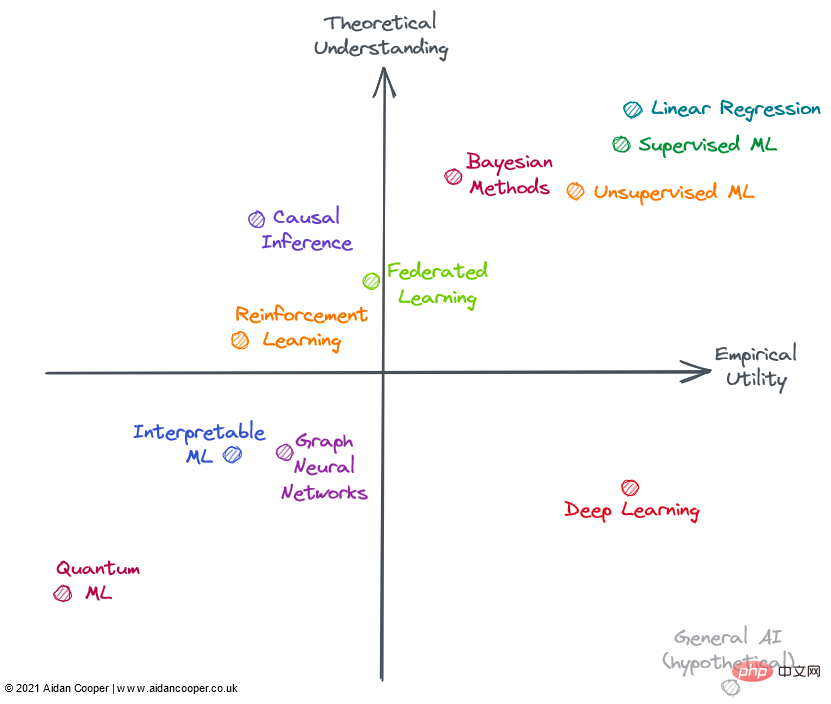
In general, we expect utility and understanding to be loosely related, such that methods with a high degree of theoretical understanding are more useful than methods with a low degree of theoretical understanding. This means that most fields should be in the lower left quadrant or the upper right quadrant. The areas away from the lower left-upper right diagonal represent exceptions. Typically, practical utility should lag behind theory because it takes time to translate nascent research theory into practical applications. Therefore, this diagonal should be above the origin, not directly through it.
Not all fields in the above picture are completely included in machine learning (ML), but they can all be applied in the context of ML or are closely related to it . Many of the areas evaluated overlap and cannot be clearly described: advanced methods in reinforcement learning, federated learning, and graph ML are often based on deep learning. Therefore, I consider non-deep learning aspects of their theoretical and practical utility.
Linear regression is a simple, easy to understand and efficient method. Although often underestimated and ignored. , but its breadth of use and thorough theoretical basis put it in the upper right corner of the figure.
Traditional machine learning has developed into a field of high theoretical understanding and practicality. Complex ML algorithms, such as gradient boosted decision trees (GBDT), have been shown to often outperform linear regression in some complex prediction tasks. This is certainly the case with big data problems. Arguably, there are still gaps in the theoretical understanding of over-parameterized models, but implementing machine learning is a delicate methodological process, and when done well, models can run reliably within the industry.
However, the extra complexity and flexibility does lead to some errors, which is why I put machine learning to the left of linear regression. In general, supervised machine learning is more sophisticated and impactful than its unsupervised counterpart, but both methods effectively solve different problem spaces.
Bayesian methods have a cult following of practitioners who tout its superiority over more popular classical statistical methods. Bayesian models are particularly useful in certain situations: point estimates alone are not enough and estimates of uncertainty are important; when data are limited or highly missing; and when you understand the data-generating process that you want to explicitly include in the model hour. The usefulness of Bayesian models is limited by the fact that for many problems point estimates are good enough and people simply default to non-Bayesian methods. What's more, there are ways to quantify uncertainty in traditional ML (they're just rarely used). Often it is easier to simply apply ML algorithms to the data without having to consider the data generation mechanism and priors. Bayesian models are also computationally expensive and would have greater utility if theoretical advances resulted in better sampling and approximation methods.
Contrary to progress in most fields, deep learning has achieved some stunning successes, even though the theoretical aspects have proven fundamentally difficult to make progress on. Deep learning embodies many of the characteristics of a little-known approach: models are unstable, difficult to build reliably, configure based on weak heuristics, and produce unpredictable results. Questionable practices like random seed "tweaking" are common, and the mechanics of the working model are difficult to explain. However, deep learning continues to advance and reach superhuman performance levels in areas such as computer vision and natural language processing, opening up a world of otherwise incomprehensible tasks, such as autonomous driving.
Hypothetically, general AI will occupy the lower right corner because, by definition, superintelligence is beyond human understanding and can be used to solve any problem. Currently, it is included only as a thought experiment.
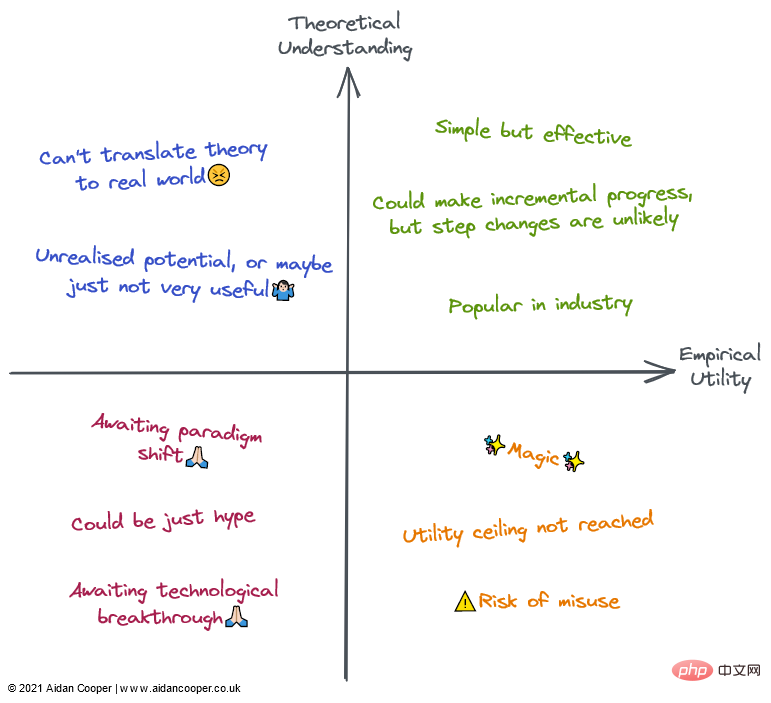
Qualitative description of each quadrant. Fields can be described by some or all of the descriptions in their corresponding regions
Most forms of causal inference are not machine learning, but sometimes they are, and Always interested in predictive models. Causality can be divided into randomized controlled trials (RCTs) and more sophisticated methods of causal inference, which attempt to measure causal relationships from observational data. RCTs are simple in theory and give rigorous results, but are often expensive and impractical—if not impossible—to conduct in the real world and therefore have limited utility. Causal inference methods essentially imitate RCTs without doing anything, which makes them much easier to perform, but there are a number of limitations and pitfalls that can invalidate the results. Overall, causality remains a frustrating pursuit, where current methods are often inadequate for the questions we want to ask, unless these questions can be explored through randomized controlled trials, or they fit neatly into some framework (e.g., as an accidental result of a "natural experiment").
Federated learning (FL) is a cool concept that has received little attention - probably because its most compelling applications require distribution to a large number of smartphone devices, so FL has only two players To really research: Apple and Google. Other use cases for FL exist, such as pooling proprietary data sets, but there are political and logistical challenges in coordinating these initiatives, limiting their utility in practice. Still, for what sounds like a fancy concept (roughly summarized as: "Put the model into the data, rather than the data into the model"), FL works and has applications in areas such as keyboard text prediction and personalized news recommendations. Tangible success stories. The basic theory and technology behind FL appear to be sufficient for wider application of FL.
Reinforcement learning (RL) has reached unprecedented levels of capability in games such as chess, Go, poker, and DotA. But outside of video games and simulation environments, reinforcement learning has yet to translate convincingly into real-world applications. Robotics was supposed to be the next frontier in RL, but that didn't happen - reality seemed more challenging than the highly constrained toy environment. That said, RL's achievements so far are encouraging, and someone who really likes chess might argue that its utility should be even higher. I'd like to see RL realize some of its potential practical applications before placing it on the right side of the matrix.
Graph neural network (GNN) is now a very popular field in machine learning, and has achieved gratifying results in many fields. But for many of these examples, it's unclear whether GNNs are better than alternatives that use more traditional structured data paired with deep learning architectures. Problems where the data are naturally graph-structured, such as molecules in cheminformatics, appear to have more compelling GNN results (although these are generally inferior to non-graph related methods). More than in most fields, there appears to be a large gap between open source tools for training GNNs at scale and in-house tools used in industry, which limits the feasibility of large GNNs outside these walled gardens. The complexity and breadth of the field suggests a high theoretical upper limit, so there should be room for GNNs to mature and convincingly demonstrate advantages for certain tasks, which will lead to greater utility. GNNs could also benefit from technological advances, as graphs currently do not fit naturally on existing computing hardware.
Interpretable Machine Learning (IML) is an important and promising field that continues to receive attention. Technologies like SHAP and LIME have become really useful tools for interrogating ML models. However, due to limited adoption, the utility of existing approaches has not yet been fully realized—robust best practices and implementation guidelines have yet to be established. However, the current main weakness of IML is that it does not address the causal question that we are really interested in. IML explains how models make predictions, but does not explain how the underlying data are causally related to them (although it is often misinterpreted like this). Before major theoretical advances, legitimate uses of IML were mostly limited to model debugging/monitoring and hypothesis generation.
Quantum Machine Learning (QML) is well outside my wheelhouse, but currently seems to be a hypothetical exercise in waiting patiently for viable quantum computers to become available. Until then, QML sat insignificantly in the lower left corner.
There are three main mechanisms through which the field traverses the theoretical understanding and empirical utility matrix (Figure 2).
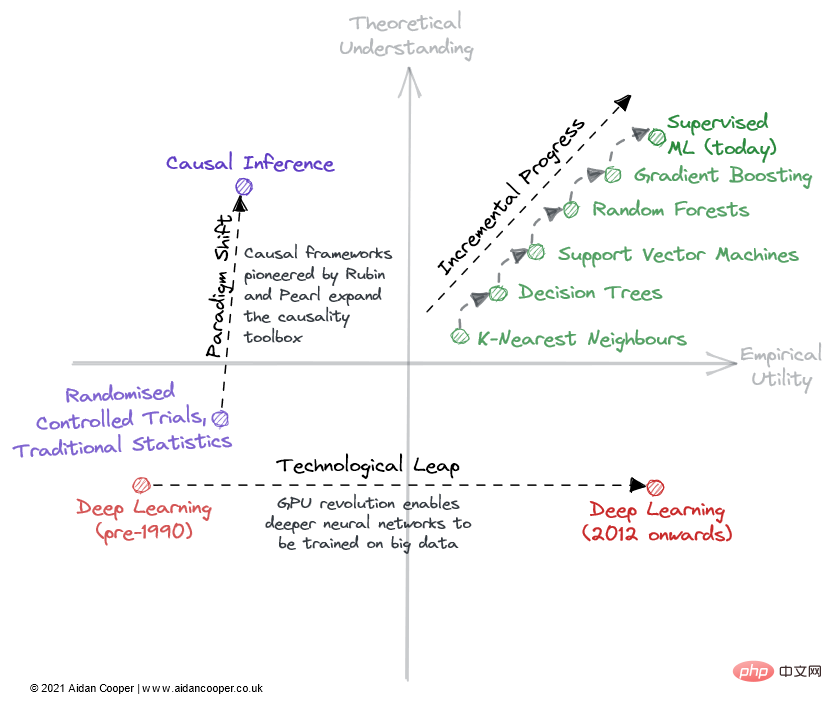
Illustrative example of the way fields can be traversed through a matrix.
Progressive progression is a slow and steady progression that moves up the inch field on the right side of the matrix. A good example of this is supervised machine learning over the past few decades, during which time increasingly effective predictive algorithms have been refined and adopted, giving us the powerful toolbox we enjoy today. Incremental progress is the status quo in all mature fields, except for periods of more dramatic movement due to technological leaps and paradigm shifts.
As a result of technological leaps, some fields have seen step changes in scientific progress. The field of *deep learning* was not unraveled by its theoretical foundations, which were discovered more than 20 years before the deep learning boom of the 2010s - it was parallel processing powered by consumer GPUs that fueled its renaissance. Technological leaps usually appear as jumps to the right along the empirical utility axis. However, not all technology-led advancements are leaps and bounds. Today's deep learning is characterized by incremental progress achieved by training larger and larger models using more computing power and increasingly specialized hardware.
The ultimate mechanism of scientific progress within this framework is paradigm shift. As Thomas Kuhn noted in his book The Structure of Scientific Revolutions, paradigm shifts represent important changes in the basic concepts and experimental practices of scientific disciplines. The causal framework pioneered by Donald Rubin and Judea Pearl is one such example, elevating the field of causality from randomized controlled trials and traditional statistical analysis to a more powerful mathematical discipline in the form of causal inference. Paradigm shifts often manifest as an upward movement in understanding, which may follow or be accompanied by an increase in utility.
However, paradigm transformation can traverse the matrix in any direction. When neural networks (and subsequently deep neural networks) established themselves as a separate paradigm from traditional ML, this initially corresponded to a decline in practicality and understanding. Many emerging fields branch off from more established areas of research in this way.
To summarize, here are some speculative predictions of what I think may happen in the future (Table 1). Fields in the upper right quadrant are omitted because they are too mature to see significant progress.
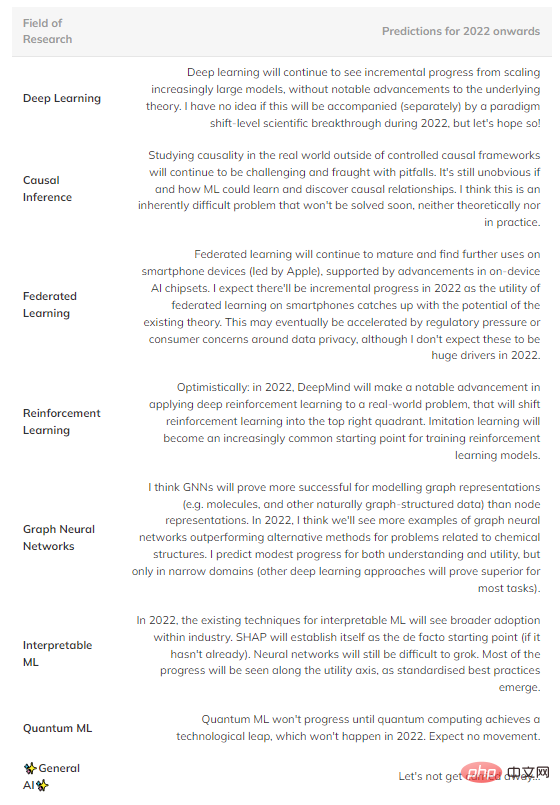
Table 1: Forecast of future progress in several major fields of machine learning.
A more important observation than how individual fields develop, however, is the general trend toward empiricism and an increasing willingness to acknowledge comprehensive theoretical understanding.
From historical experience, generally theories (hypotheses) appear first, and then ideas are formulated. But deep learning has ushered in a new scientific process that subverts this. That is, methods are expected to demonstrate state-of-the-art performance before anyone focuses on theory. Empirical results are king, theory is optional.
This has led to systematic widespread gaming in machine learning research of getting the latest state-of-the-art by simply modifying existing methods and relying on randomness to surpass the baseline, rather than meaningfully advancing theory in the field. Results. But maybe that’s the price we pay for this new wave of machine learning boom.
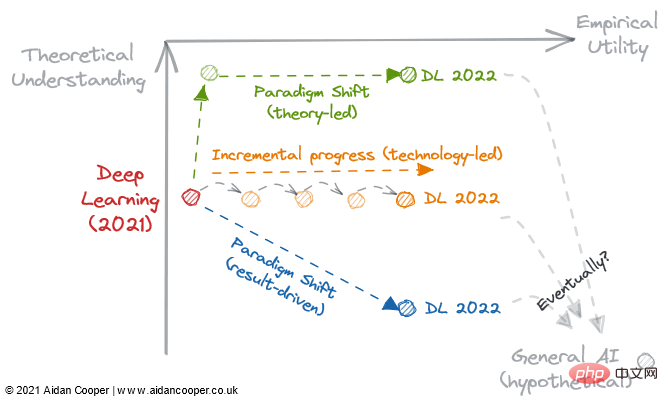
Figure 3: 3 potential trajectories for deep learning development in 2022.
Whether deep learning irreversibly becomes a results-oriented process and relegates theoretical understanding to optionality, 2022 may be the turning point. We should consider the following questions:
Will theoretical breakthroughs allow our understanding to catch up with practicality and transform deep learning into a more structured discipline like traditional machine learning?
Is the existing deep learning literature sufficient to allow utility to increase indefinitely, simply by scaling to larger and larger models?
Or will an empirical breakthrough lead us further down the rabbit hole, into a new paradigm that enhances utility, even though we know less about it?
Do any of these routes lead to general artificial intelligence? Only time will tell.
The above is the detailed content of How to evaluate the reliability of the theoretical foundation of machine learning?. For more information, please follow other related articles on the PHP Chinese website!
 Application of artificial intelligence in life
Application of artificial intelligence in life
 What is the basic concept of artificial intelligence
What is the basic concept of artificial intelligence
 How to solve the problem of forgetting the power-on password of Windows 8 computer
How to solve the problem of forgetting the power-on password of Windows 8 computer
 How to use fit function in Python
How to use fit function in Python
 How to enable secondary logon service
How to enable secondary logon service
 Is the matcha platform formal?
Is the matcha platform formal?
 How to be invisible online on TikTok
How to be invisible online on TikTok
 Representation method of string constant
Representation method of string constant




